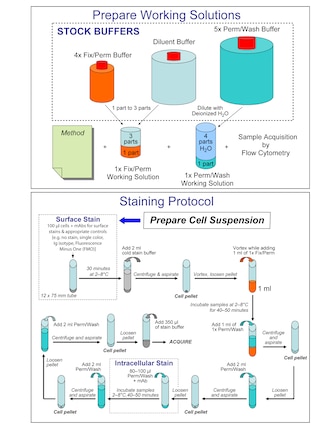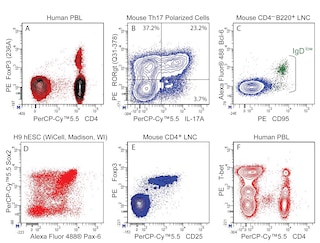-
Training
- Flow Cytometry Basic Training
-
Product-Based Training
- BD FACSDiscover™ S8 Cell Sorter Product Training
- Accuri C6 Plus Product-Based Training
- FACSAria Product Based Training
- FACSCanto Product-Based Training
- FACSLyric Product-Based Training
- FACSMelody Product-Based Training
- FACSymphony Product-Based Training
- HTS Product-Based Training
- LSRFortessa Product-Based Training
- Advanced Training
-
- BD FACSDiscover™ S8 Cell Sorter Product Training
- Accuri C6 Plus Product-Based Training
- FACSAria Product Based Training
- FACSCanto Product-Based Training
- FACSLyric Product-Based Training
- FACSMelody Product-Based Training
- FACSymphony Product-Based Training
- HTS Product-Based Training
- LSRFortessa Product-Based Training
- United States (English)
-
Change country/language
Old Browser
This page has been recently translated and is available in French now.
Looks like you're visiting us from {countryName}.
Would you like to stay on the current country site or be switched to your country?


.png)

Two-color flow cytometric analysis of TCF-7/TCF-1 expression. Left Panel - Human peripheral blood mononuclear cells (PBMC) were fixed and permeabilized with the BD Pharmingen™ Transcription Factor Buffer Set (Cat. No. 562574/562725). The cells were then stained with PE-Cy™7 Mouse Anti-Human CD4 antibody (Cat. No. 557852) and either PE Mouse IgG1, κ Isotype Control (Cat. No. 554680; Left Plot) or PE Mouse Anti-TCF-7/TCF-1 antibody (Cat. No. 564217; Right Plot). Right Panel - Mouse splenic leucocytes (SPL) were similarly fixed and permeabilized. The cells were then stained with PE-Cy™7 Rat Anti-Mouse CD4 antibody (Cat. No. 552775) and either PE Mouse IgG1, κ Isotype Control (Left Plot) or PE Mouse Anti-TCF-7/TCF-1 antibody (Right Plot). Two-color flow cytometric dot plots show the correlated expression patterns of CD4 versus TCF-7/TCF-1 for gated events with the forward and side light-scatter characteristics of intact cells. Flow cytometric analysis was performed using a BD LSRFortessa™ Cell Analyzer System.
.png)

BD Pharmingen™ PE Mouse Anti-TCF-7/TCF-1
.png)
Regulatory Status Legend
Any use of products other than the permitted use without the express written authorization of Becton, Dickinson and Company is strictly prohibited.
Preparation And Storage
Recommended Assay Procedures
BD® CompBeads can be used as surrogates to assess fluorescence spillover (compensation). When fluorochrome conjugated antibodies are bound to BD® CompBeads, they have spectral properties very similar to cells. However, for some fluorochromes there can be small differences in spectral emissions compared to cells, resulting in spillover values that differ when compared to biological controls. It is strongly recommended that when using a reagent for the first time, users compare the spillover on cell and BD® CompBeads to ensure that BD® CompBeads are appropriate for your specific cellular application.
Product Notices
- Please refer to www.bdbiosciences.com/us/s/resources for technical protocols.
- Since applications vary, each investigator should titrate the reagent to obtain optimal results.
- An isotype control should be used at the same concentration as the antibody of interest.
- Caution: Sodium azide yields highly toxic hydrazoic acid under acidic conditions. Dilute azide compounds in running water before discarding to avoid accumulation of potentially explosive deposits in plumbing.
- For fluorochrome spectra and suitable instrument settings, please refer to our Multicolor Flow Cytometry web page at www.bdbiosciences.com/colors.
- Species cross-reactivity detected in product development may not have been confirmed on every format and/or application.
- Please refer to http://regdocs.bd.com to access safety data sheets (SDS).
- For U.S. patents that may apply, see bd.com/patents.
Companion Products






The S33-966 monoclonal antibody specifically binds to TCF-7 (Transcription factor 7) which is also known as TCF-1 (T-cell factor 1). TCF-7 is a member of the High Mobility Group (HMG) DNA binding protein family of transcription factors. TCF-7 is expressed in thymocytes, T lymphocytes and proliferating epithelial cells. TCF-7 is expressed in the earliest T cell precursors and serves as a critical transcriptional regulator that is involved in the differentiation of thymocytes to become mature T lymphocytes. TCF-7 is necessary for the survival of immature CD4+CD8+ thymocytes. TCF-7 can also promote the differentiation of mature peripheral T cells to become Th2-like cells. TCF-7 may also function as a transcriptional repressor of certain target genes including CTNNB1 and TCF7L2. The S33-966 antibody crossreacts with human TCF-7.

Development References (5)
-
Chen Z, Ji Z, Ngiow SF, et al. TCF-1-Centered Transcriptional Network Drives an Effector versus Exhausted CD8 T Cell-Fate Decision.. Immunity. 2019; 51(5):840-855.e5. (Clone-specific: Flow cytometry). View Reference
-
Germar K, Dose M, Konstantinou T, et al. T-cell factor 1 is a gatekeeper for T-cell specification in response to Notch signaling. Proc Natl Acad Sci U S A. 2011; 108(50):20060-20065. (Biology). View Reference
-
Johnson JL, Georgakilas G, Petrovic J, et al. Lineage-Determining Transcription Factor TCF-1 Initiates the Epigenetic Identity of T Cells.. Immunity. 2018; 48(2):243-257.e10. (Clone-specific: Flow cytometry). View Reference
-
Weber BN, Chi AW, Chavez A, et al. A critical role for TCF-1 in T-lineage specification and differentiation. Nature. 2011; 476(7358):63-68. (Biology). View Reference
-
Yu Q, Sharma A, Oh SY, et al. T cell factor 1 initiates the T helper type 2 fate by inducing the transcription factor GATA-3 and repressing interferon-γ. Nat Immunol. 2009; 10(9):992-999. (Biology). View Reference
Please refer to Support Documents for Quality Certificates
Global - Refer to manufacturer's instructions for use and related User Manuals and Technical data sheets before using this products as described
Comparisons, where applicable, are made against older BD Technology, manual methods or are general performance claims. Comparisons are not made against non-BD technologies, unless otherwise noted.
For Research Use Only. Not for use in diagnostic or therapeutic procedures.
Report a Site Issue
This form is intended to help us improve our website experience. For other support, please visit our Contact Us page.